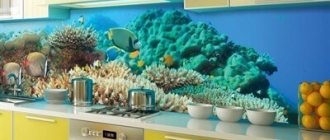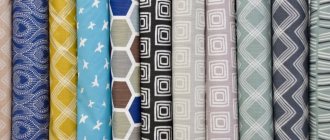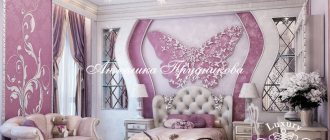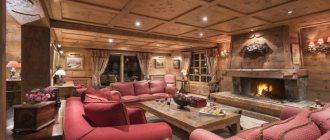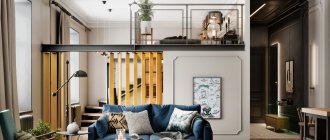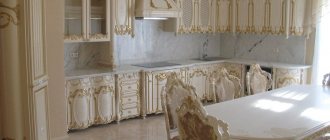What is kitsch?
Translated from German, the word “Kitsch” means bad taste, hack work, fakes. The term began to be used when elements of fine art began to be mass-produced, and their quality often left much to be desired.
Products that fell under the Kitsch term were sentimental, dramatic, and even cloying.
Many experts believe that the movement only imitates real art and is devoid of creativity; as such, there is no imagination here either. However, over time, kitsch appeared in the interior as an independent genre. Let's take a closer look at the history of its origin and production.
Kitsch: style, bad taste or swearing?
“What kitsch!” - a phrase equivalent to “Ugh, damn it!”, only in relation to design and objects of art. For some, at best, the word “kitsch” will bring to mind Lady Gaga, while for others, sugary, stamped crafts of the kind you can get at the office as a New Year’s gift.
But what exactly is kitsch, and where did this word come from? Was it always an insult and has it not, by chance, become a praise in recent years? Let's talk.
“Officially, the concept of “kitsch” (German kitsch) came into use in the 60s of the 19th century, and was used as a synonym for the words “vulgarity”, “cheap” or “bad taste” - for objects of mass production and dubious artistic value. The word goes back to two German verbs: kitschen - “to hack” and verkitschen - “to sell”. Actually, these two words provide a comprehensive description of how and why objects in the kitsch style were created.
If you think about it, the decoration of the apartment of the average Soviet citizen consisted of kitsch a little more than entirely. Clumsy porcelain sets and crystal candy bowls, shepherdesses and elephants in the windows, chandeliers with “palace” pendants on 2.5-meter-high ceilings - the brilliance and poverty of Soviet interiors would make a whole company of dandies faint. But the inhabitants of the USSR had at least a relative justification: it was difficult to get anything else, pre-revolutionary interiors were considered rather an anti-example (and an object of Freudian envy), and they wanted comfort - and even more so status. Residents of 19th-century Germany had no such excuse.
Cattle have a peculiarity: It is always not you. And this is amazing. G. L. Oldie
The phenomenon of the emergence of kitsch was well described by the American art critic Clement Greenberg in his work “Avant-garde and Kitsch” [1]. In his opinion, kitsch is a product of the urbanization of society and the elimination of illiteracy. If earlier culture in its “high” sense was accessible only to those who knew how to read and write, and in itself set the threshold for entry, then with the resettlement of rural residents to cities and teaching them to write and read, it “popped up.”
Seeing how everything was arranged for the rich, but not quite understanding why it was needed, society responded with kitsch: items that existed more for status and “so that they were no worse than the neighbor’s” (or even the daughter of the millionaire Vanderbilt!). As Greenberg himself put it:
“In order to satisfy the demand of the new market, a new product was invented - ersatz culture, kitsch, intended for those who, while remaining indifferent and insensitive to the values of genuine culture, still experienced spiritual hunger...”
If you manage to read this phrase without disgusted intonations, take yourself some candy (hopefully not from a crystal candy bowl). It didn't work out for me.
Here another one is revealed to us - and a very important one! – the side of kitsch: the ability of artists to classify themselves as “not like that.” Calling the work of a competitor in the industry kitsch has become an insult comparable to cursing a family to the seventh generation and a beloved dog. Very soon there was practically no one left whose work would not be called kitsch at least once. The modernists included adherents of the academic style, the avant-gardeists - the romantics, and even William Bouguereau himself, a professor at the French Higher School of Fine Arts, did not escape this fate.
This cycle, in turn, gave birth to a host of creative individuals who compensated for the lack of talent by trying to get as far away from the definition of kitsch as possible. They avoided understandable plots (ideally, plots in general), excessive sentimentality and clearly recognizable emotions - being proud not of the level of their work, but of the fact that they did not in any way resemble mass art. At the same time, such individuals strictly followed the main rule of kitsch: sacrificing artistic value to status (in this case, the status of someone who is called a “fiction” on the modern Internet [2]).
In her dissertation “Kitsch as a Sociocultural Phenomenon” [3] N.A. Konradova very successfully sums it up: there are no unambiguous criteria for kitsch - and there have been cases when the attitude towards the same work fluctuated along a sinusoid from “pop” to “masterpiece” " Kitsch is a concept that is too dependent on fashion, the opinions of popular critics and what is considered vulgar and what is considered elitist today. Even if the Universe takes pity on humanity and the majority begins to like works of “high” art, there will still be those who will call it kitsch and create an elitist counterculture. Because they can.
“On the little finger of his left hand there was a huge ring; on the last joint of the nameless […] real gold with iron stars soldered to it. But in order to display other jewels, he exposed his right arm to the very shoulder...” [4] Petronius, “Satyricon.” 1st century AD Although it would seem...
The description of the freedman Trimalchio lacks only a crimson jacket to complete the image. But despite the presence of massive rings, bracelets (and a crimson cloak!) Trimalchio is not a “new Russian” - he is a “new Roman”. However, at his feast, colorfully described in Satyricon, he does things that would be enough for a whole collection of jokes from the nineties. His home and lifestyle are the perfect description of ancient Roman kitsch, which Petronius - dubbed by his contemporaries as the "arbiter of grace" - satirizes in every aspect.
The name kitsch could have been invented in the 19th century, but its descriptions are found throughout history, starting from antiquity. And, as we see, little changes in them. In the era of bourgeois revolutions, the term “nouveau riche” (from the French “new rich man”) appeared - to which the fame of Trimalchio and, later, the love of kitsch were firmly established. It is not known whether this was the revenge of the offended aristocracy, or whether the wealthy bourgeoisie was really drawn to porcelain shepherdesses and endless plates - but the word “nouveau riche” has become almost synonymous with bad taste.
Now the market was responding to a new request, and kitsch found a “second wind.” Consumers accustomed to cheap mass-market products have received a new status. And to emphasize this status, they wanted the same mass market, but in gold and with stones. Famous jewelers and artists cried, took drugs, but took orders that they were ashamed to sign.
Endless cupids, cherubs, stucco and gilding on the principle of “the more the better” reproduced the palace style to the letter - but in spirit they were closer to a teenager’s room covered with posters than to the Louvre. Alas, the phenomenon not only did not fade away, but also reached a terminal stage in some places in the form of golden loaves, portraits in Caesar’s robes and fur coat stores.
Technically, this no longer falls under the definition of kitsch - as cheap, low-quality goods that have no artistic value. After all, almost everything in such interiors is piecework, for which hundreds and thousands of man-hours are senselessly and mercilessly wasted. And yet, everything together perfectly imitates kitsch. If some part of the artists tries to move as far as possible from mass culture, then the other half gives up - and begins to repeat it, but at a higher level, for the new elite. To complete this ring of suffering, all that was needed was the design of kitsch as an independent style...
Interesting read: Art Deco. At the intersection of classics and modernity
“Why art criticism treated him with disdain is not so easy to explain. Perhaps because Kinkade was selling kitsch, although even art critics have a hard time separating kitsch from art.” D. Thompson. Supermodel and plywood box.
“If you can’t win, lead.” History does not know who was the first to get tired of his work being called kitsch, and decided to elevate it to the rank of style - but the fact remains: now “to be different from everyone else” means to be like everyone else, but better than everyone else. Kitsch as a style is sarcasm embodied, irony (if not outright mockery) of its “natural” manifestations.
“to be different from everyone else” means to be like everyone else, but better than everyone else
Like any other style, kitsch has developed several main directions. One of them is lumpen kitsch : aggressive, bright, with graffiti covering bare walls, polyethylene curtains and cheap plastic furniture (which may look like it came straight from the trash heap, but cost as much as the average metropolitan salary). The overall impression makes you check your wallet and remember whether you are really from that area.
The rebellious mood of lumpen kitsch is opposed to romantic kitsch . Deadly for allergy and asthma sufferers, the romantic kitsch rooms are full of pink, fluffy, lace and embroidery. Country, Provence and Barbie house styles are mixed in it in such unnatural proportions that they create an effect that Lovecraft never dreamed of. It’s hard to believe that there isn’t a pentagram hidden under the layers of Hello Kitty rugs – all this innocence looks too artificial.
Of course, pseudo-luxury was not ignored.
It is difficult for the untrained eye to determine whether this is designer irony, or whether the owners of the apartment have recently been appointed to a new position in the administration - but knowledgeable people say that the criteria exist. The main one is a feeling of comfort. If you are not inclined to raise ostriches in your backyard, but you enjoy being in such an interior, most likely, it is not the bad taste of the owners that has “tried” here, but the good taste of their designers. How to steal a house: plagiarism in architecture
The main principle of creating an interior in the kitsch style is “all the best at once.” You can paint all the walls with graffiti and cover them with posters - or you can say hello to the porcelain shepherdesses and arrange the interior in the style of lumpen kitsch, “a truck overturned in the yard with a shortage.” You can paranoidly follow the classic style, with stucco even in the toilet (especially in the toilet!), or combine neon lamps with Chinese vases and leopard skin to create an “expensive-rich” effect. You can follow at least some dollhouse logic, collecting, for example, only pink - or simply drag home everything “cute” in unlimited quantities.
If you manage to create an interior in which you won’t get a migraine in an hour and the desire to immediately escape from there in a day, congratulations, you have completed the highest feat of design aerobatics: mastered kitsch and tastefully mocked the lack of taste. Now the beauty in this world has a slightly better chance of survival.
Text: Daria Tsepkova
Illustrations: Elena Zublevich
Art Deco: at the intersection of classics and modernity
art
Art Deco: at the intersection of classics and modernity
“Severe style”: the romantic face of official art of the 1960s
art
“Severe style”: the romantic face of official art of the 1960s
Aesthetics of the nineties: what we were like
art
Aesthetics of the nineties: what we were like
From Art Nouveau to Art Deco: Aesthetics and Semiotics
art
From Art Nouveau to Art Deco: Aesthetics and Semiotics
Life without show-offs. Constructivism as an architectural style and worldview. Part I
art
Life without show-offs. Constructivism as an architectural style and worldview. Part I
Women artists of the Renaissance
art
Women artists of the Renaissance
Kandinsky, Mondrian, Malevich: common paths of non-objective art
art
Kandinsky, Mondrian, Malevich: common paths of non-objective art
Effel, Larson, Bidstrup: what are the kings of caricature capable of?
art
Effel, Larson, Bidstrup: what are the kings of caricature capable of?
Friedensreich Hundertwasser: healing architecture - and yourself
art
Friedensreich Hundertwasser: healing architecture - and yourself
Sources and links:
[1] Avant-garde and kitsch. Clement Greenberg. 1939 [2] Fiction. Lurkmore. [3] Kitsch as a sociocultural phenomenon. N. A. Konradova. Moscow. 2001 [4] Ancient literature. B. A. Gilenson [5] Supermodel and plywood box. Shocking stories and the bizarre economics of contemporary art. Donald Thompson.
About style
One of the definitions of the word “kitsch” is pseudo-art designed for external effect. At the end of the 19th century, the concept meant mass production of art, cheap figurines, paintings imitating objects of art. It was a game of luxury, an imitation of the elite of society. Reproductions of famous paintings, commissioned from street artists, appeared in poor houses and hotels.
Molded frames painted with bronze paint replaced gilded baguettes. Later, plaster piggy banks, porcelain elephants and fish, and painted ceramics joined the items with a pretense of luxury.
In the USSR, these subjects were considered philistinism, and they tried to eradicate the external attributes of the bourgeoisie. But the style lived by its own laws, kitschy things coexisted with accessories made of glass and plastic, photographs of film actors, carpets, and strict rectangular furniture. The combination of these incompatible items helped to decorate dull walls and bring comfort to barracks, communal apartments, and Khrushchev-era apartment buildings. Today kitsch is a fashion trend, a mixture of Provence, modernism, retro, and functionalism.
The interior is created spontaneously or purposefully, and is conventionally divided into three directions.
Tips for choosing kitsch furniture
Furnishing a room in kitsch style is at the same time the easiest and most difficult task. There are absolutely no principles or requirements for choosing furniture. It can come in different styles, shapes and sizes. Furniture can be made from absolutely any materials. For example, a completely acceptable combination for a kitsch style could be a table made of glass and chrome and an antique sideboard from the 19th century. The cheapest option is furniture brought from a landfill or pulled out from the attic: sofas of the last century, old folding beds, plastic tables, stools. People who have enough money and do not accept any restrictions in anything can flaunt luxury furniture at their discretion. A kitsch design trend may well recommend a combination of vintage chic armchairs near an electric fireplace. Kitsch furniture should be original: its shape, textile upholstery, inserts made of various materials, its location in the room (a chair in the center of the room, a low table instead of a bed, mugs instead of flower pots) may be unusual.
Varieties of Kitsch style
Interior design in the Kitsch style is divided into “spontaneous” (unconscious) and “intentional”. Conventionally, it can be divided into three directions:
Kitsch lumpen
The kitsch of the lumpen is dictated by poverty. This includes mismatched furniture, outdated interior items, and cheap trinkets. Lumpen kitsch is an indicator of the author’s low standard of living and unconventional thinking.
A teenager's room can also be a hub of lumpen kitsch. The rebellious spirit and youthful maximalism here can manifest themselves in the form of graffiti and rich acid colors in the interior. There are also unusual, diverse items, many of which are very unexpected - for example, road signs or lamp posts.
Pseudo-luxury Kitsch
Pseudo-luxurious kitsch style is an interior design in which there is a noticeable desire to emphasize imaginary well-being by any means. This is an interior in the design of which, instead of natural finishing materials, their imitation is used. This is a room where numerous luxury items are presented, often of dubious quality.
And this is an interior that inept designers, wanting to put “the best on display,” “stuff” everything indiscriminately, forgetting about style.
The availability of funds, the use of the most fashionable natural finishing elements, expensive furniture and rich decorations also do not guarantee that the Kitsch style will not be formed in the end. If, for example, you place a Country-style fireplace, expensive oriental vases and modern fluorescent lamps in one interior, you will get an unconscious pseudo-luxurious Kitsch.
The kitchen and bedroom are the rooms in which unconscious kitsch is most often formed. Interior design always requires a professional approach and a sense of proportion.
Designer Kitsch
Design Kitsch is intentional. Only it can be considered a true interior design style. The style is controversial, but, nevertheless, it rightfully occupies its own separate niche in the art of interior design. The Kitsch style is found in the works of many famous designers. Only the most experienced of them can afford to resort to this style. After all, this is a kind of hooliganism, irony, a subtle mockery of the classical canons of design art, a provocation.
Intentional kitsch style is the ability to combine incompatible things. This is "art for art's sake." The kitchen, living room, youth cafe are the most popular places for experiments in the kitsch style.
Features of kitsch style
Like any other style in the art of interior design, the Kitsch style has its own individual characteristics:
Mixing a variety of styles in one interior
The kitchen is the most common example of such spontaneous kitsch. This room quite often represents a “vinaigrette”, for example, from the classical style, futurism and country style.
Mixing styles and colors in the living room
Brown-red kitchen interior in kitsch style
Disharmony of colors and shapes
The Avant-garde style, as mentioned earlier, gave birth to the Kitsch style, and therefore the color palette and shapes used in these two styles would seem to be identical. But there is a significant difference. The interior, designed in the Avant-garde style, has a harmony of colors and shapes. For example, bright color accents (such as furniture) in the interior always contrast with a light background. And in the Kitsch style there is a complete absence of any color rules and boundaries! All colors of the spectrum, including acidic ones, are used in interior design in the Kitsch style beyond all measure. And strict geometric forms coexist here with formlessness. A real riot of colors and shapes, dissonant with each other!
Kitsch style in a children's room
Black and white living room in kitsch style
Combination of incompatible materials
The materials used in the Kitsch style are contradictory. Using them together in any other style would be considered bad form, but not in the Kitsch style. Czech glass and plastic, velvet and faux fur, “marble” columns and linoleum, chrome and gilding - everything can be used, and at the same time.
Combination of red, blue and yellow in a kitsch living room
White interior in kitsch style with bright accents
Using mismatched furniture
The Kitsch style can simultaneously combine any furniture - modern, rare, of different shapes, different styles, from different sets. A kitsch bedroom can be home to an old cheap iron bed and an elegant dressing table. And a kitchen in the same style is the perfect place for an antique sideboard, Soviet-era stools and modern built-in appliances. Why not? This is Kitsch style! The main thing here is shocking!
Red pink and cream colors in a kitsch living room
Unusual bedroom furniture in kitsch style
A large number of trinkets and decorative elements in the interior
The kitsch style welcomes the presence of a huge number of decorative details in the interior - figurines and busts, reproductions of paintings and posters, postcards and dolls, candlesticks and watches, openwork napkins and lambrequins, designer souvenirs and consumer goods. It is desirable that there be a lot of all these pleasant trinkets and preferably in one place.
This is what the Kitsch style dictates - the style of contradictions and creative chaos.
Unusual apartment interior in kitsch style
White, yellow and black colors in a kitsch living room
Bedroom with fireplace in kitsch style
Designer creative furniture in the living room in kitsch style
Who chooses the Kitsch style
Intentional (designer) Kitsch is a rather rare phenomenon. This is a challenge to established canons and rules, it is a parody of relics of the past, emphasizing modern achievements. Only very brave, creative, mostly young people - rebels in spirit - can afford to use the Kitsch style in the interior. And these are also people trying to make themselves known and attract attention.
This category can include the creative elite (bohemians). Designer Kitsch – “crazy” youth, courage and refined taste.
Distinctive features of “kitsch” in different interiors
Kitsch in the interior is a triumph of bad taste. Flashiness, loudness, mannerism, vulgarity - none of these definitions will reflect the content of the concept deeply and succinctly. This is not a demonstration of bad taste, but rather a parody, a claim to originality, a challenge to the usual, a provocation of public opinion.
- This style has no rules, no consistency, no common features. He expresses freedom and triumphs in its splendor. Pseudo-historicism constitutes a worthy alternative and competes with modern reality. This is a caricature of style, a kind of parody that shocks and brings confusion to the usual attitude towards life.
- Kitsch is most common in the living room of a modern apartment. Living rooms and studio spaces are the most suitable. Combining many functions, rooms turn into accumulations of a wide variety of things and objects.
Interior design in the kitsch style can affect the kitchen, nursery or bedroom, but rarely. Any room at home can turn kitschy if you try hard enough.
The main signs that this is a kitsch interior:
- fountain at home;
- columns and balusters in an apartment with low ceilings, stucco molding and busts;
- all kinds of imitations “under”:
– wood effect (plastic),
– marbled (linoleum),
– under crystal (glass),
– under the skin (dermantine),
– under gold (gilding),
– “antique”, etc.;
- reproductions of famous paintings, next to them are posters, posters, vinyl records;
- carpets.
The symbolic archetype of the kitsch style in the interior can be considered a pink pillow, decorated with hand embroidery, lying on a green plastic chair, which stands under a Renaissance painting hanging on a wall made of rough logs.
Style is not “carried away” by creative searches and discoveries; its destiny is ready-made samples, recognizable and popular, banal and widespread.
The mechanism of aesthetic influence lies in the analogies that the unconscious draws between what the rich have (according to ideas and experience) and what they have at home.
Characteristic features of the style
Nevertheless, even in such a contradictory style, several inherent features can be identified:
- disharmony in design colors, shapes and materials. For example, the use of matte muted colors along with acidic, intense ones; the use of classic or standard furniture together with futuristic furniture; wood or stone along with glossy plastic.
- In decoration, furniture and decor there are obvious signs of different interior styles.
- The items on display range from very old to modern and trendy.
- Imitation of everything that can be imitated - “marbled” linoleum, “crystal” glass chandelier, “leather” sofa, actually covered with dermantine, plastic wall panels “like wood”, artificial “animal skin”, gilded polyurethane friezes, etc. . P.
How to “introduce” it into your home interior
Creating kitsch at home is not easy or difficult - desire and means will help with this. It is worth taking a close look at the furniture and walls, decoration and accessories: which of them combines and harmonizes with each other, and which openly contradicts? Enhancing contrasts by moving them closer or placing them side by side, or making bright accents on a dull plain background is not enough.
New, original ideas are needed - things found at flea markets and antique stores.
Combining the incongruous is the surest way to achieve interior design in this style.
Design methods:
- paint the walls with spray paint from cans, using different colors;
- cover part of the floor with ceramic tiles in oriental style;
- put on the floor a carpet consisting of several pieces of different colors;
- place large pots with palm perennials near the walls;
- make stucco inserts or imitation columns on the walls;
- hang plastic curtains and put up screens;
- make partitions from light decorative materials inside one room, etc.
In general, the kitsch style in the interior is more suitable for young people. The older generation will instantly create a dump of things and a pile of old things at home, and the youth will make sure that everything old is thrown away and promptly replaced with new ones. The negative side also has a right to exist.
Everyone has their own idea of the beauty of everyday life. The pleasure of refuting the usual authorities sometimes prevails even over the inconvenience of everyday life.
This style is an integral part of modern culture. It is considered a combination of classic, country and futurism. The leading trend of the crisis era has every chance of turning into a full-fledged hyper-style of art. A kind of neo-version of mannerism, kitsch operates with familiar things, taken out of their context and placed in a completely opposite one.
This is the first sign that the culture of the surrounding world is increasingly turning into a culture of consumption.
Peculiarities
This style in the interior is very easy to identify by strange, unusual and chaotic solutions, which definitely should not be located nearby. By the way, if plastic is actively used in pop art, handmade is completely unacceptable. Boho is made entirely from natural materials and does not allow modern style in any form. Shebbishik welcomes aged items in pastel colors, and bright colors are unacceptable here because they destroy the idea and zest of this style. Then kitsch is a green hand-embroidered blanket on a bright plastic chair under a replica of a painting by an 18th century artist located on a wooden wall... So, it will not be difficult to understand that the kitsch style does not welcome any clear guidelines. Such a composition of bad taste is a real and defining concept for precisely defining this style.
Related article: How to fit brightly colored doors into the interior of a room?
Advice! To decorate your interior in this style, don’t be afraid to imagine and experiment!
Kitsch seems to mock artistic, “difficult” styles, and he himself is like a caricature . Interior design in this style is always distinguished by bright colors and combines completely inappropriate decorative elements. However, everything is not limited to the color palette and decorative items; in kitsch, the emphasis can also be on other unusual items - like furniture or even the layout.
Color variety
A riot of colors, aggressive acidic shades, bright patterns creates artistic ugliness and a good mood. Key tones: lime, bright red, indigo, fuchsia, canary yellow, rich pink, golden.
In one room it is allowed to use several opposite colors and contrasting patterns. The focus is on the walls, which are painted in different colors and covered with wallpaper with abstract and floral prints.
In a kitsch interior, even the floor should catch the eye. The surface is covered with multi-colored tiles, floor coverings with intricate patterns, and imitation of unplaned boards. Carpets are chosen bright, with alternating multi-colored squares and leopard prints. The ceilings amaze with their colorful 3D patterns, red, purple, and green colors.
To prevent a space oversaturated with bright colors from becoming boring, neutral shades are chosen for the walls, which will smooth out the tension and highlight colorful collages, paintings, and posters.
Living room
When decorating a living room in a kitsch style, do not be afraid of bright, rich colors and shades. Red, purple, orange, green, pink - all those colors that immediately catch your eye. The walls can be painted, any design can be drawn on them, and for cladding in this style it is very appropriate to use records, newspapers, magazines, and road signs. Kitsch is personal expression, so don’t be afraid to be individual and unique. You can use an elite sofa as furniture; furniture of different shades and colors will look great. A fireplace, which can be either ancient or modern, will add a touch of romance and comfort. You can decorate the living room with a mirror in a beautiful frame, paintings, crafts, and cute trinkets.
Kitsch and fusion - what's the difference?
Despite the fact that both styles involve combinations of different elements, there are differences between them.
- If kitsch arose in the mid-19th century with one of the tasks - to bring culture to the masses, then fusion appeared relatively recently - in the 70s - 80s of the 20th century.
- When arranging a setting in a fusion style, it is important that it is perceived harmoniously, as a single whole. This is not necessary for kitsch - it can be chaotic and expressive.
- Fusion is based on traditional styles, some of them may be close to each other, while kitsch is a bold combination of opposite and even incompatible directions. Moreover, kitsch often involves a combination of the brightest and most pronounced elements from different genres.
And again about styles (kitsch, eclecticism, glamour)
And again I return to styles...
(start a conversation about styles here)
Greetings to everyone who is interested.
How often do we say these words today: glamour, eclecticism, kitsch... and most often they have a pronounced negative meaning for us.
How often do we think about what really stands behind these words? And are these really synonyms of bad taste...
I invite you to think about this...
Perhaps we should start with eclecticism - to pay tribute to its age - as a style it appeared at the beginning of the 19th century.
Unfortunately, chaotically selected elements of furniture and decor are often called eclecticism.
And indeed, eclecticism not only allows for this, but is also unthinkable without it. However, not everything is so simple...
The emergence of eclecticism is associated with some fatigue from the rigid framework of previous classical styles and a thirst for novelty. Eclecticism was a natural reaction to the severity of classicism.
The style is based on the rejection of rigid rules and canons, a mixture of two or three styles that are close to each other.
And yet, eclectic compositions are created according to the principle of similarity, within the framework of design trends that harmoniously combine with each other and do not contradict each other. A harmonious combination of materials, colors, and textures is a must.
Those. You can combine objects from different eras in one composition, but something must unite them: shape, line, texture or color.
The “eclectic” style in the interior is characterized by the use of a large amount of textiles, numerous pillows, an abundance of decor, vintage items and handmade furniture.
Can you imagine what kind of knowledge, flair and taste you need to have in order to harmoniously combine household items from different eras?
Sometimes interiors created in this style look truly harmonious and aesthetically balanced...
And what is glamor ?... (French glamour, [glamur], English glamour, ['glm], actually “charm”, “charm”, “charm”)
There is no unity in the interpretation of this concept even among fashion and style specialists.
Some perceive glamor as a bright, youthful trend, multicolored in shiny rhinestones. And others mean by this luxury in everything. The French even believe that glamor is more about behavior than appearance or clothing, and call sensual beauty glamor.
But everyone is united by the opinion that, first of all, glamor is shocking, the desire to stand out, to be noticeable.
Historically, glamor is inextricably linked with the heyday of the Hollywood “dream factory” in the 30-50s of the 20th century. Glamor is the style of Hollywood stars.
So what does the Glamor style imply in the interior?...
Spacious rooms, expensive materials, a large number of mirrors, natural fur and leather, black gloss, golden iridescent surfaces, rhinestones, flowers (not only fresh, but also artificial ones of good quality), expensive textiles... - everything that can produce an effect.
Colors: black, white, honey shades, red accents.
The main thing that distinguishes true glamor is naturalness and no affectation or mannerisms.
Glamor is an expensive style. It requires not only significant investments in creating such an interior, but also corresponding costs for maintaining it in proper form.
Don't be afraid of glamor, don't call it names))). You just need to understand that glamor is a way of life that requires a good sense of proportion!
And finally, kitsch (German: Kitsch - hack, bad taste, “cheap”)
Let's look at the dictionaries...:
“...many believe that the word “kitsch” arose in the art markets of Munich in the 60s and 70s of the 19th century as a designation for cheap, quickly selling paintings and sketches and was born either from a distorted English sketch (“sketch”, “sketch” "), or as an abbreviation of German verkitschen - “to vulgarize”. Kitsch appealed to the raw feelings of the newly enriched Munich bourgeoisie, ... "
With the beginning of the era of consumption and aggressive advertising, an era in which art was finally and irrevocably put on the commercial stream, many talented cultural figures began to simplify and tailor their works to the taste of the crowd - not only and not so much for the sake of profit, but simply to expand the audience.
So kitsch is everything that is bright, shiny, flashy, intrusive and deliberately vulgar.
Kitsch is elephants on the sideboard, swans as an integral part of the landscape, garden gnomes... The denial of decency and conventions, the compatibility of incongruous things - these are the basic principles of kitsch... In one word, “bad taste”, “cheapness”, “falsehood”, “sweetness” and etc.
There is a basis for these judgments. But since... Kitsch is not art, and cannot be assessed by the criteria of art.
It is impossible not to admit that kitsch is a phenomenon that is extremely relevant in modern culture, object kitsch, literary, musical, television... The combination of bright and understandable with low cost makes kitsch popular and widespread. And, perhaps, if we treat this phenomenon with a certain degree of irony , then this publicly accessible luxury and riot of colors will make our lives a little brighter?)))
The conclusion suggests itself: - in order to work in these styles, you need to have excellent taste, although they themselves are often perceived by us as tasteless!!!
Furnishing an apartment in kitsch style
Let's look at the ideas and techniques for arranging an apartment in the kitsch style that designers use.
Living room
In this room it is advisable to allow the style to reveal itself as much as possible. Start with the walls. Wallpaper, paint, and plaster can be used as finishing materials. They can be combined, and if you use one type, be sure to contrast colors, brightness, and texture.
Often designers apply patterns in the Art Nouveau or Baroque style to brightly colored walls. One of the walls may be brickwork or pop art style.
- You can make the walls in one expressive color, focusing on wall decor and multi-colored furniture in different styles.
- A kitsch style living room is also characterized by furniture with different textures. For example, create a set of an avant-garde sofa with a smooth finish and deep, soft armchairs in the Baroque or Empire style. The combination will be interesting if such furniture is of a similar color - a red sofa and scarlet armchairs.
- A vintage table or a radically opposite high-tech glass table will complement the sofa area.
- If the walls are close to the classics, decorate them with pop art posters, and if modern trends prevail on the coverings, complement them with reproductions of famous paintings, preferably paintings.
- A glossy stretch ceiling can be decorated with a central pompous Baroque chandelier. The lighting does not need to be central. With the help of floor lamps and lamps, the emphasis is placed on the desired details.
Bedroom
The bedroom should be conducive to sleep and passive pastime. Therefore, it is important not to overdo it with flashy combinations.
- Start decorating this room from the walls. Make a contrast of textures - a glossy finish and textured textiles with a predominance of the latter, preferably in the lower part of the walls with a horizontal combination.
- For furniture, use elements characteristic of both modern and classic interiors.
- For example, next to an avant-garde bed there can be elegant baroque-style nightstands with curved legs. Colorful pop art curtains and floor lamps with multi-colored shades can complement the kitsch in the bedroom.
- Use textiles, such as soft Provence pillows or patchwork. The latter option is also preferable for bedspreads and carpets.
- If the room is dominated by classic elements from different styles, focus on modern, expressive decor. If the bedroom has more modern pieces, choose decor in the style of the 19th and early 20th centuries.
Kitchen
The kitchen can combine a kaleidoscope of bright colors and contrasts. Choose rich tones that have a positive effect on your mood and awaken your appetite - orange, green, coral, yellow, purple. Bright colors can be slightly diluted with pastel colors.
- Use patchwork tiles. It is a special combination of different colors and patterns. Stores sell ready-made options, but you can combine your own or with the help of a designer.
- It is advisable to use patchwork and his choice to make one or more walls, make the others plain and decorate with decor that is radically different from the style of the walls and the day.
- If the walls emanate modernity, the dining table and chairs will be classic - wooden with abundant carved decor.
- Sometimes designers, when arranging a kitchen, when solving problems, combine art deco in the dining area and pop art, where food is prepared. This environment is complemented by loft-style elements - air ducts under the ceiling, painted in bright colors.
Kitchen
In the kitchen, rich orange, green, yellow, and coral colors are used for decorating walls and furniture fronts, curtains and tablecloths with floral motifs. Tiles of different shades and patterns in patchwork style are sold especially for cladding floors and walls. When arranging a room, the work area can be highlighted with loft elements: steel pipes, imitation brickwork, open communications. The dining area will be decorated with a dark vintage buffet combined with bright plastic chairs and stools. In a modestly decorated room, the emphasis is on kitchen utensils. The concept of direction is emphasized by plates made of porcelain and plastic, multi-colored mugs, frying pans and stewpans hung on the wall. Painted vases, candy bowls, and fruit bowls will create the right atmosphere.
In small kitchens, it is not recommended to overload the surfaces with ornaments, so as not to visually make the room smaller.
Useful tips
It is advisable to use and name several sources for lighting. For example, spot class light and a classic crystal chandelier, candelabra and central lighting with metal shades in the loft style.
There are no impossible combinations of colors, brightness and textures in the style. The greater the search and contrast, the more expressive it will be.
- Wall trim can be painted with paint sprayed from an aerosol can.
- The new ceiling is most often finished to match the walls or remains neutral. There are examples of interiors where the ceiling is decorated with posters.
- Place posters and antique paintings (for sale) nearby.
Kitsch according to the rules. Laws of style from designers
Law 1.
The main rule of kitsch is to create unprofessional fakes, something fashionable, momentary, spectacular, eye-catching, made from scrap materials.
Law 2.
This is anti-design, designed to fight established traditions and give the individual the freedom to be different from everyone else.
Law 3.
A favorite theme of the kitsch style is pseudo-historical architecture and interiors.
Law 4.
The style is characterized by the use of a large number of inexpensive decorations in interior decoration - pictures, toys, figurines, etc., as well as the use of bright, incompatible colors.
Law 5.
The main materials are plastic curtains, homemade partitions, wall art made from aerosol cans of bright acid paints and furniture found in a landfill.
The style of the famous contemporary American artist Jeff Koons, who is known for his passion for kitsch, especially in sculpture. The yacht he created is a unique structure, it looks like an assembled puzzle, and the dynamic color combination of surfaces expressively catches the eye.
Materials
Various materials are used in interior design. The main thing is not to try to use everything and more in one design - leather, plastic, gold, silk and faux fur. You can achieve the opposite effect - at the end of decorating the room it will seem and share that the design lacks completeness, a final emphasis.
The style and thoughtful purpose of the kitsch interior is considered a good choice for those who do not have enough money to buy expensive materials. So, instead of natural parquet, you can lay linoleum under the tree, replace silk with satin, and glass with transparent plastic.
Lighting
When choosing light sources for a kitsch interior, there is no single system. Therefore, it is better to give preference to several lighting devices in different styles. For example, in order to choose and decorate a living room in an antique style, you can use a chandelier and wall sconces for relaxation according to the name in the pseudo-classical and classical genre in the form of candelabra with candles.
The popularity of kitsch in interior design
- It cannot be said that kitsch is a popular genre in decorating a house or apartment. However, it can often be found in trendy cafes, restaurants and other establishments, despite the fact that this is disharmony.
- Apartment interior design in kitsch style is the choice of creative people with a rich imagination who do not accept stereotypes. They are ready to break the strict rules that society dictates to them with high demands.
- If you do not hesitate to invite guests to your home, where reproductions of famous artists are combined with cheap decor, but on the contrary, you want the decor to impress and reflect your y creativity, pay attention to this style.
Textiles, decor, accessories
Textile decor changes the perception of even modest, discreet rooms. A pink and lime fur throw adds a kitschy look to an otherwise basic bed. The missing luxury is added by curtains made of plush, velvet, satin, sofa cushions, and voluminous lambrequins. Columns, arches, fireplace portals made of plaster and chipboard add ceremonial splendor.
Tips: enhance the style of doors with ornate patterns and gilding. Posters, pages from magazines, graffiti on walls, records from which stands, shelves, and frames are made, look and fit well into the flexible framework of lumpen kitsch.
The situation is complemented by:
- interior stuffed animals;
- fake art objects;
- figurines, figurines made of crystal, porcelain, glass;
- ethnic accessories and equipment;
- decorative boxes;
- busts;
- mirrors;
- openwork napkins;
- talismans, amulets;
- compositions made of artificial flowers.
Room decoration
The main requirement for the premises is entertainment, a bold combination of objects from different styles. To get an original interior, the room is filled with kitsch elements and a chaotic mix of accessories. The cheapest design option is to replace the upholstery on chairs and sofas, lampshades, or a vintage decorated figurine from a flea market. The end result, if you didn’t know, looks very unusual.
Animal prints, acidic shades, and a combination of antique and modern furniture will help add dissonance to a classic style project.
It is easier to create a kitsch style in a room that has not been transformed since the times of the USSR. To Soviet minimalism it is enough to add mirrors and paintings in elegant frames. Dressers and sideboards can be decorated with copper handles and ceramics, lined with self-adhesive film or painted. Old magazines make interesting collages. Cut out pictures and headings are pasted onto thick cardboard and inserted into a frame.
Finishing walls, ceilings and floors
The kitsch style in the interior of the apartment is expressed in bright colors of large surfaces: walls, floor and ceiling. Linoleum is often used as a floor covering, imitating certain expensive finishes: wood, stone. A self-leveling, 3D floor with the effect of depth and perspective is appropriate in such an interior. One of the obligatory decorations of rooms in the kitsch style is lamps, a map, a carpet of bright, rich colors, and a futuristic shape.
The carpet can have an animalistic Chinese print; a pattern imitating the skin of a leopard is especially popular; there are also kitchen carpets made of faux fur with long pile, as a symbol of luxury and shockingness.
The walls are covered with wallpaper, including liquid, paper, textured, fabric, embossed, plain or with a floral print. Contrasting finishing with coatings of different colors and textures, painting in any colors, painting, cabinets, graffiti, decorative plaster, photo wallpaper with perspective, imitation stone, brick, wood, metal, volumetric panels, full-wall mirrors are allowed.
To find more ideas for apartment design, you should follow famous designers. These individuals and companies often maintain their own blog and leave their website contacts for feedback. and if it is Moscow, it will be easier for you to contact them.
The ceiling, as a rule, is decorated with plastic stucco, rosettes for chandeliers, moldings, and can be painted in any full color.
An alternative to whitewashing and painting is a multi-level ceiling with LED lighting (in other interior styles this technique is already considered bad manners, but kitsch accepts everything), mirror coating, palace-style painting, as well as any designs and ornaments, including glow-in-the-dark ones.
Kitsch directions
Experts divide this eccentric style into three main areas:
1. Lumpen kitsch. This direction appeared thanks to poverty! The bleakness of such rooms is diluted with bright colors, rich shades and unusual accessories. Features: acid colors, graffiti, lamp posts, road signs and even phone booths!
2. Pseudo-luxurious kitsch: a combination of wealth and lack of taste. The incredible ideas of the nouveau riche find their embodiment in this design option. One kitsch room might combine Greek columns painted in neon colors, gold moldings and plastic chairs.
3. Designer kitsch: a competent parody of style. Only professional designers can create kitsch in a home, one glance at which will make it clear that this is ridiculing specific features of the style. The main thing is not to bring it to the point of absurdity.
